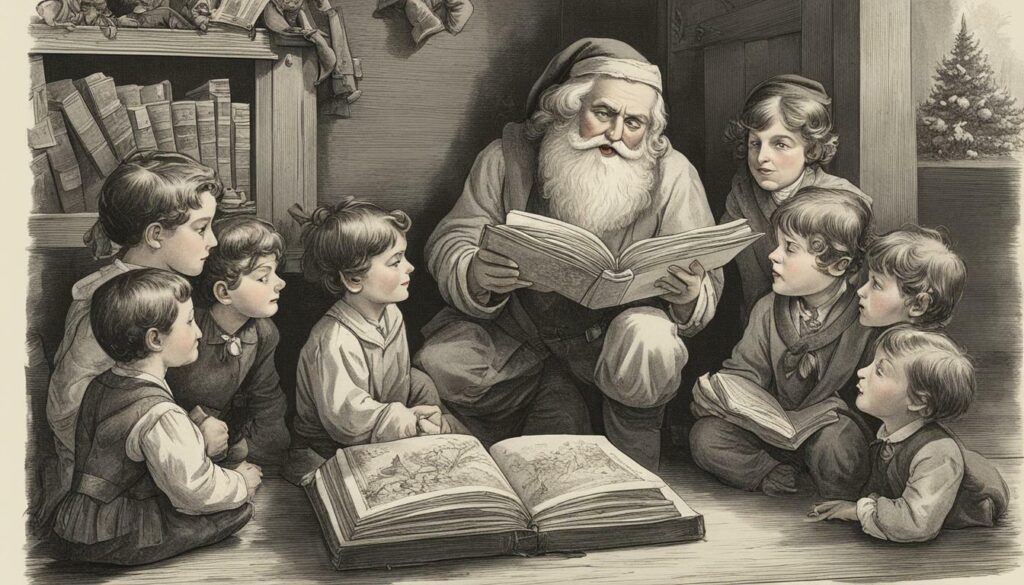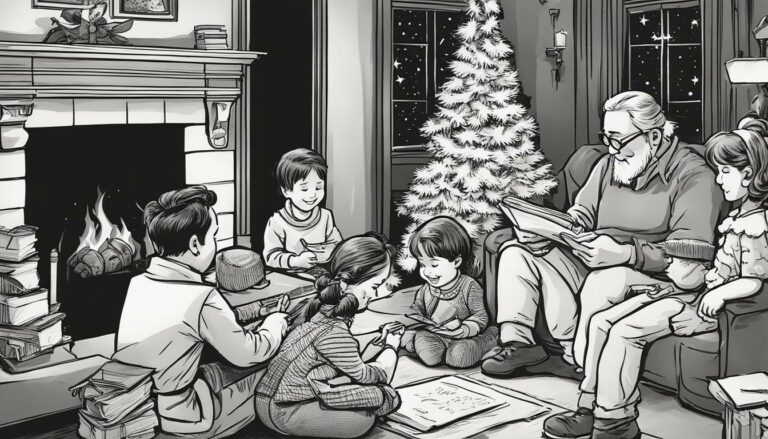The Science of Santa: How to Answer Kids’ Questions
Santa Claus is a beloved figure during the Christmas season, but as kids grow older, they inevitably start questioning his existence. However, there is historical evidence of St. Nicholas, the inspiration for Santa Claus, going back to the 3rd century. The New York Sun’s famous 1897 editorial, “Yes, Virginia, there is a Santa Claus,” affirms that he exists. It’s important to respond to kids’ questions about Santa in a thoughtful and sensitive manner. As children start to probe for answers, parents should pay attention to how the questions are asked and consider when it might be time to address their doubts. The average age for kids to stop believing in Santa Claus is around 8.4 years old, but it can vary. When revealing the truth, parents should acknowledge and validate their child’s emotions and focus on the positive aspects associated with Santa, such as generosity and kindness. Parents can also involve their children in keeping the spirit of Santa alive by encouraging them to engage in selfless acts of giving. Additionally, it’s helpful for Santa actors to know how to respond to awkward or challenging questions from kids, such as requests for specific presents or questions about Santa’s appearance. Ultimately, the goal is to preserve the magic and wonder of Santa Claus while also encouraging critical thinking and promoting the values associated with the holiday season.
- There is historical evidence of St. Nicholas, the inspiration for Santa Claus, dating back to the 3rd century.
- Parents should respond to kids’ questions about Santa in a thoughtful and sensitive manner.
- The average age for kids to stop believing in Santa Claus is around 8.4 years old.
- When revealing the truth about Santa, parents should focus on the positive aspects associated with him, such as generosity and kindness.
- Parents can involve their children in keeping the spirit of Santa alive by encouraging selfless acts of giving.
The Historical Evidence of Santa Claus
There is historical evidence of St. Nicholas, the inspiration for Santa Claus, going back to the 3rd century. St. Nicholas was a Christian bishop in Myra, which is now present-day Turkey. He was known for his acts of kindness and generosity, especially towards children. St. Nicholas became the patron saint of sailors, merchants, and children, and his popularity spread throughout Europe.
One of the most famous stories about St. Nicholas involves him providing dowries for three sisters who could not afford to get married. He secretly tossed bags of gold through their window, which landed in their stockings hung by the fireplace to dry. This act of giving became associated with St. Nicholas, and stockings have been a traditional part of Christmas ever since.
The New York Sun’s famous 1897 editorial, “Yes, Virginia, there is a Santa Claus,” reaffirms the existence of Santa Claus. In response to a letter from a young girl, the editorial assures her that Santa Claus is real, explaining that he exists as “certain unseen forces are always working for the children’s best interests.” This editorial has become a symbol of the enduring belief in Santa Claus and the magic of Christmas.

The historical evidence of St. Nicholas and the enduring belief in Santa Claus contribute to the magic and wonder of Christmas. As parents navigate the questions and doubts of their children, they can draw upon these historical facts to provide a thoughtful and sensitive response. It is important to preserve the spirit of Santa Claus while also encouraging critical thinking and promoting the values associated with the holiday season.
Addressing Kids’ Doubts About Santa Claus
It’s important to respond to kids’ questions about Santa in a thoughtful and sensitive manner. As children start to probe for answers, parents should pay attention to how the questions are asked and consider when it might be time to address their doubts. The average age for kids to stop believing in Santa Claus is around 8.4 years old, but it can vary.
“Yes, Virginia, there is a Santa Claus,” affirms the famous 1897 editorial from the New York Sun. While Santa Claus may not physically exist, there is historical evidence of St. Nicholas, the inspiration for Santa Claus, going back to the 3rd century. This historical connection can be used to explain to children the origins of Santa Claus and the traditions associated with him.
When revealing the truth about Santa, parents should acknowledge and validate their child’s emotions. It’s natural for children to feel a mix of disappointment and curiosity. By emphasizing the positive aspects associated with Santa, such as generosity, kindness, and the spirit of giving, parents can help children understand the symbolism behind Santa Claus and appreciate the values he represents.
“Santa Claus represents the joy of giving and the magic of the holiday season. Even though he may not physically exist, we can still keep his spirit alive by showing love and compassion to others,” explains child psychologist Dr. Sarah Johnson. “By engaging in selfless acts of giving, children can continue to experience the joy of being Santa and spreading holiday cheer.”

Parents can involve their children in keeping the spirit of Santa alive by encouraging them to engage in selfless acts of giving. This could include donating toys or clothes to those in need, volunteering at a local charity, or participating in community service projects. By doing so, children can experience the joy of being Santa themselves and understand the true meaning of the holiday season.
Addressing Santa Claus Myths
It’s common for children to come across various myths and stories about Santa Claus. As parents, it’s important to address these myths and provide accurate information. Santa Claus research and studies have shown that these myths often originate from different cultural traditions and adaptations of the Santa Claus story.
| Santa Claus Myth | Explanation |
|---|---|
| Santa Claus lives at the North Pole. | The concept of Santa Claus living at the North Pole is a fictional idea that became popularized over time. |
| Santa Claus travels around the world in one night. | The idea of Santa Claus delivering gifts to children worldwide in a single night is symbolic of the magic and wonder associated with the holiday season. |
| Santa Claus knows if you’ve been naughty or nice. | The notion of Santa Claus knowing whether children have been naughty or nice is a way to encourage good behavior and remind children of the importance of kindness and compassion. |
By discussing these myths with children and providing context, parents can help them understand the cultural significance and symbolism behind Santa Claus. This approach fosters critical thinking skills and encourages children to question and explore the traditions and beliefs associated with the holiday season.
The Right Time to Reveal the Truth
As children start to probe for answers, parents should pay attention to how the questions are asked and consider when it might be time to address their doubts. The average age for kids to stop believing in Santa Claus is around 8.4 years old, but it can vary. Some children may start questioning earlier, while others may continue to believe for longer.
It’s important for parents to gauge their child’s readiness to hear the truth about Santa Claus. Some signs that a child may be ready include asking more specific questions about Santa’s logistics, expressing skepticism or doubts, or hearing information from their peers. When children reach this stage, it becomes crucial for parents to handle the situation with sensitivity and compassion.
When revealing the truth, it’s essential to acknowledge and validate a child’s emotions. They may feel disappointment, sadness, or even anger. Parents should emphasize that while Santa Claus may not be a physical being, the spirit of Santa, which represents kindness, generosity, and the magic of the holiday season, continues to exist. This can help children transition from the belief in a literal Santa Claus to a broader understanding of the values associated with him.
To further ease the transition, parents can involve their children in keeping the spirit of Santa alive. Encouraging them to engage in selfless acts of giving, such as participating in charity drives or helping others in need, can help reinforce the positive values associated with Santa Claus. By focusing on the joy of giving and the importance of kindness, parents can help their children understand that the magic of Santa is not lost, but rather transformed into something more meaningful.
| Signs a child may be ready: | Ways to handle the truth: |
|---|---|
| Asking specific questions about Santa’s logistics | Acknowledging and validating a child’s emotions |
| Expressing skepticism or doubts | Focusing on the positive aspects associated with Santa |
| Hearing information from peers | Involving children in selfless acts of giving |
“The joy of giving and the kindness associated with Santa Claus can continue to exist in our lives, even after we realize the truth.”
The Importance of a Thoughtful Approach
While it may be challenging to reveal the truth about Santa Claus, it is an essential aspect of a child’s development. By addressing their doubts with care and empathy, parents can guide their children through this transition and help them appreciate the values and magic that Santa represents. Remember, the goal is not to diminish the holiday spirit, but rather to foster critical thinking and promote the joy of giving that Santa embodies.

Remember to insert the complete table at the end.
When revealing the truth, parents should acknowledge and validate their child’s emotions and focus on the positive aspects associated with Santa, such as generosity and kindness. It’s crucial to create a safe space for children to express their feelings and ask questions. By empathizing with their emotions, parents can help their child navigate the transition from belief to understanding.
One effective approach is to emphasize that the magic of Santa Claus is not just about the physical existence of a jolly man in a red suit, but rather the spirit of giving and the joy of the holiday season. Parents can highlight how Santa Claus represents the values of love, compassion, and selflessness. Encouraging children to embrace these qualities in their own lives can help them move forward with a positive outlook.
A helpful strategy is to involve children in a discussion about the history and traditions of Santa Claus. Sharing the story of Saint Nicholas and how he became associated with gift-giving can provide children with a deeper understanding of the origins of the Santa Claus legend. This can also be an opportunity to explain the different cultural variations of Santa Claus around the world, fostering a sense of inclusivity and curiosity.
| Tip 1: | Listen to your child’s questions and concerns without judgment. Create an open and accepting environment for them to express themselves. |
|---|---|
| Tip 2: | Focus on the positive values associated with Santa Claus, such as generosity, kindness, and the spirit of giving. |
| Tip 3: | Encourage critical thinking by discussing the history and origins of Santa Claus, exploring different cultural traditions. |
“The joy of Santa Claus comes not from his physical existence, but from the love, generosity, and magic he represents.”
Example:
Parent: “I know you’ve been curious lately about Santa Claus, and I want you to know that I’m here to listen and answer any questions you have.”
Child: “Is Santa Claus real? Some kids at school say he’s not.”
Parent: “It’s completely normal to have questions about Santa Claus. What do you think?”
Child: “I don’t know. I want to believe in Santa, but I’m not sure.”
Parent: “That’s okay. Santa Claus represents the spirit of giving and the joy of the holiday season. Even though there isn’t a physical person delivering presents, we can still celebrate the magic of Santa by being kind and generous to others.”
Child: “So, Santa is about love and giving?”
Parent: “Exactly! The joy of Santa Claus comes not from his physical existence, but from the love, generosity, and magic he represents. And remember, the traditions and stories of Santa Claus have been cherished for centuries by people all over the world.”

When revealing the truth about Santa Claus, parents should acknowledge and validate their child’s emotions while focusing on the positive aspects of Santa, such as generosity and kindness. Emphasizing the spirit of giving, discussing the history and cultural variations of Santa Claus, and encouraging critical thinking can help children transition from belief to understanding while preserving the magic and wonder of the holiday season.
Keeping the Spirit of Santa Alive
Parents can also involve their children in keeping the spirit of Santa alive by encouraging them to engage in selfless acts of giving. This not only helps instill the values of kindness and generosity but also keeps the magic of Santa Claus alive in their hearts. One way to do this is by participating in charity events during the holiday season. Families can donate toys, clothes, or food to those in need, teaching children the importance of helping others and making a positive impact in their community.
Another way to keep the spirit of Santa alive is by writing letters to Santa. Children can express their wishes, but it’s important to emphasize the importance of gratitude and empathy in their letters. Encouraging them to also ask Santa how they can help others during the holidays helps foster a sense of compassion and selflessness.
Creating a Santa tradition within the family can also help maintain the magic of Santa Claus. This can include leaving out cookies and milk for Santa on Christmas Eve or setting up reindeer food in the yard. By actively participating in these traditions, children can continue to believe in the enchantment of Santa Claus and experience the joy of the holiday season.

Responding to Challenging Questions about Santa
It’s helpful for Santa actors to know how to respond to awkward or challenging questions from kids, such as requests for specific presents or questions about Santa’s appearance. One effective strategy is to redirect the focus back to the magic of the holiday season and the joy of giving. Santa can emphasize that the true spirit of Christmas lies in the act of selflessness and generosity, rather than the materialistic aspect of receiving gifts.
When faced with specific gift requests, Santa can explain that while he tries his best to fulfill every child’s wishes, sometimes it’s not possible to grant all requests due to various reasons. Santa can take this opportunity to highlight the importance of appreciating the thought and effort behind each gift, regardless of its size or material value.
For questions about Santa’s appearance, Santa can playfully remind children that he appears differently to different people because he wants to bring joy to everyone in a way that resonates with them. This allows children to appreciate and respect diversity while maintaining the enchantment of Santa Claus.

By maintaining a positive and imaginative approach, Santa actors can navigate challenging questions with grace and keep the magic of Santa alive for children. Remember, the focus should always be on promoting the values of kindness, generosity, and love that Santa represents during the holiday season.
Conclusion
Ultimately, the goal is to preserve the magic and wonder of Santa Claus while also encouraging critical thinking and promoting the values associated with the holiday season.
As children grow older, it is natural for them to question the existence of Santa Claus. However, historical evidence dating back to the 3rd century confirms the inspiration behind Santa Claus, St. Nicholas. The famous 1897 editorial from The New York Sun, “Yes, Virginia, there is a Santa Claus,” reaffirms his existence and the joy he brings.
When children start asking questions about Santa, it is crucial for parents to respond thoughtfully and sensitively. Paying attention to the way these questions are asked can help determine when it might be time to address their doubts. On average, children stop believing in Santa Claus around 8.4 years old, but this age can vary from child to child.
When the time comes to reveal the truth about Santa, parents should acknowledge and validate their child’s emotions. It is important to emphasize the positive aspects associated with Santa, such as his generosity and kindness. By focusing on these qualities, parents can teach their children the importance of giving and spreading happiness during the holiday season.
In order to keep the spirit of Santa alive, parents can involve their children in selfless acts of giving. Encouraging children to participate in charitable activities or making presents for others can help instill the values associated with Santa Claus, fostering a sense of empathy and compassion.
For Santa actors who may encounter challenging questions from kids, it is helpful to be prepared with appropriate responses. Whether it is handling specific gift requests or inquiries about Santa’s appearance, Santa actors can navigate these situations with grace and creativity, keeping the magic alive for children.
In conclusion, while addressing children’s questions about Santa may require delicate handling, the ultimate goal is to preserve the enchantment of Santa Claus while also encouraging critical thinking and promoting the values that make the holiday season special.
FAQ
Q: Is there historical evidence of Santa Claus?
A: Yes, there is historical evidence of the inspiration for Santa Claus, St. Nicholas, dating back to the 3rd century. The famous 1897 editorial, “Yes, Virginia, there is a Santa Claus,” published in The New York Sun, affirms his existence.
Q: How should parents respond to kids’ questions about Santa?
A: Parents should respond thoughtfully and sensitively to kids’ questions about Santa. They should pay attention to how the questions are asked and consider when it might be time to address any doubts.
Q: At what age do kids typically stop believing in Santa Claus?
A: The average age for kids to stop believing in Santa Claus is around 8.4 years old, but it can vary. Parents should consider their child’s readiness to hear the truth and respond accordingly.
Q: How should parents handle revealing the truth about Santa Claus?
A: When revealing the truth about Santa Claus, parents should acknowledge and validate their child’s emotions. They should focus on the positive aspects associated with Santa, such as generosity and kindness.
Q: How can parents keep the spirit of Santa alive?
A: Parents can involve their children in keeping the spirit of Santa alive by encouraging them to engage in selfless acts of giving. This helps to maintain the magic of the holiday season and the values associated with Santa Claus.
Q: How can Santa actors respond to challenging questions from kids?
A: Santa actors should be prepared to handle challenging questions from kids, such as specific gift requests or questions about Santa’s appearance. They can redirect the focus to the joy of the holiday season and the values Santa represents.







